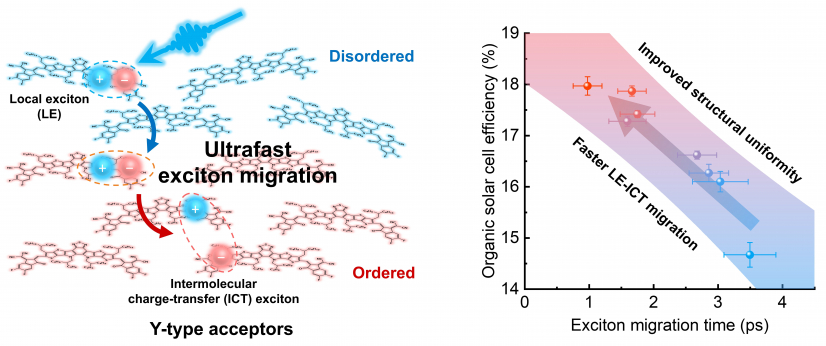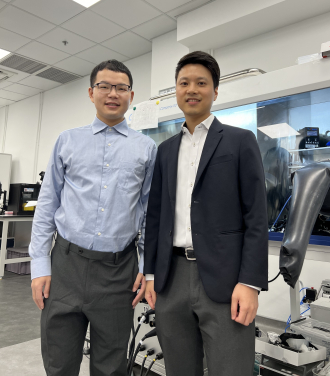Media
Enhancing solar energy harvesting: HKU Engineering researchers unlock the key to efficient organic photovoltaics
28 Nov 2024

The research uncovers a direct relationship between the exciton migration time (time for exciton movement from disordered to ordered areas) and structural disorder, which has significant implications on the charge transport property and the overall solar conversion efficiency of organic solar cells based on these materials. Image modified from Guo et al, Energy & Environmental Science (2024).

The research uncovers a direct relationship between the exciton migration time (time for exciton movement from disordered to ordered areas) and structural disorder, which has significant implications on the charge transport property and the overall solar conversion efficiency of organic solar cells based on these materials. Image modified from Guo et al, Energy & Environmental Science (2024).
- 1 / 2
- 2 / 2
A team of researchers led by Professor Philip C.Y. Chow from the Department of Mechanical Engineering at the University of Hong Kong (HKU) has made a breakthrough in the field of organic photovoltaics. Their research has revealed how the structure of organic photovoltaic (OPV) materials affect their performance, providing critical insights for future OPV material development. The discovery has been published in Energy & Environmental Science in an article entitled “Engineering ultrafast exciton dynamics to boost organic photovoltaic performance”.
What is organic photovoltaics (OPV)?
OPV is a promising emerging solar technology that could be used to power devices in a variety of innovative ways. Unlike traditional solar panels, which are made from rigid inorganic materials, OPV is made from organic (carbon-based) materials, giving them unique benefits. OPV is lightweight, flexible, affordable, and non-toxic, making it ideal for use in city buildings and in wearable devices.
While OPV is not yet as efficient as traditional solar panels, it has shown great potential. Over the past five years, its efficiency in converting solar energy into electricity has improved significantly, from around 10% to over 20%. This progress is largely attributed to the development of a series of new materials known as Y-type acceptors. However, the lack of full understanding by scientists regarding the workings of these molecules has impeded further advancements.
Discovery by the research team
Utilising advanced tools, Professor Chow’s research team has revealed how the structure of Y-type acceptors impacts their performance in OPV devices. The key findings are:
- Key behaviors of excitons: When sunlight hits an OPV material, it generates excitons (electron-hole pairs bound by Coulombic force). In Y-type acceptors, excitons transition from less organised (disordered) regions of the material to more organised (ordered) regions. The team has found a way to track this rapid movement, which occurs incredibly fast within picoseconds, or trillionths of a second.
- Better-organised molecules perform better: The researchers found that OPV materials with molecules that are neatly and uniformly packed enable excitons to move more quickly from disordered to ordered regions. The enhanced movement of excitons in Y-type acceptors is strongly linked to the improved solar conversion performance of the corresponding OPV devices.
- The sweet spot for performance: Interestingly, the researchers discovered that Y-type acceptors perform optimally when the molecules are neither overly tightly packed nor too loosely packed. This “just right” (optimal) level of organisation results in a more uniform material, facilitating more efficient movement of excitons and enhancing the overall performance of OPV devices.
Why does this matter?
This research is significant because it provides scientists a clearer understanding of how to design better materials for OPV. By grasping the connection between a material’s structure, its response to sunlight, and its performance, researchers can develop more efficient, reliable, and affordable solar technologies. With further development, OPV has the potential to supplement traditional solar panels, offering a sustainable energy solution for urban cities, wearable technologies, and more. In essence, the findings brings us closer to creating flexible, affordable, and high-performance solar devices that can help power a greener future.
This study was conducted in collaboration with Professor Yuanping Yi's team from the Institute of Chemistry, Chinese Academy of Science (CAS), Professor Hongzheng Chen's team from Zhejiang University, Professor Xinhui Lu’s team from the Chinese University of Hong Kong, and Professor Xiaomin Xu’s team from Tsinghua University. This interdisciplinary collaboration allowed for the integration of expertise from multiple research groups, including ultrafast optical spectroscopy, quantum chemical modelling, X-ray scattering and device manufacturing. Mr Yu Guo, a PhD student in Professor Chow's team at HKU, and Professor Guangchao Han in Professor Yi’s team at CAS were the co-first authors of this study.
About the paper
Yu Guo‡, Guangchao Han‡, Jing Guo, Haotian Guo, Yuang Fu, Xiaodan Miao, Zhen Wang, Dongsheng Li, Shuixing Li, Xiaomin Xu, Xinhui Lu, Hongzheng Chen, Yuanping Yi* and Philip C. Y. Chow*. Engineering ultrafast exciton dynamics to boost organic photovoltaic performance. Energy Environ. Sci., 2024,17, 8776-8786. (‡ These authors contributed equally; * Corresponding authors)
Link to the paper: https://pubs.rsc.org/en/content/articlelanding/2024/ee/d4ee03315a.
About Professor Philip C.Y. Chow
Professor Philip Chi Yung Chow received his B.Sc. from Imperial College London, and M.Phil. and Ph.D. in Physics from the University of Cambridge. He is currently an Assistant Professor in the Department of Mechanical Engineering at HKU. His multidisciplinary research group at HKU focuses on the study and development of optoelectronic and photonic devices with applications in solar energy, wearable electronics and green buildings. He was awarded the UK EPSRC Doctoral Training Award in 2010, JSPS Overseas Postdoctoral Research Fellowship in 2016, the Hong Kong RGC Early Career Scheme in 2022, and the NSFC Excellent Young Scientist Fund in 2022.
Media Enquiries:
Faculty of Engineering, HKU
Ms Christina Chung (Tel: 3910 3324; Email: chungmc@hku.hk)

